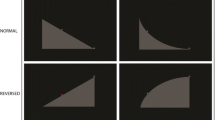Abstract
Previous work indicates that extrapolation of object motion during occlusion is affected by the velocity of the immediately preceding trial. Here we ask whether longer-term velocity representations can also influence motion extrapolation. Red, blue or green targets disappeared behind an occluder. Participants pressed a button when they thought the target had reached the other side. Red targets were slower (10–20 deg/s), blue targets moved at medium velocities (14–26 deg/s) and green targets were faster (20–30 deg/s). We compared responses on a subset of red and green trials which always travelled at 20 deg/s. Although trial velocities were identical, participants responded as if the green targets moved faster (M = 22.64 deg/s) then the red targets (M = 19.72 deg/s). This indicates that motion extrapolation is affected by longer-term information about the typical velocity of different categories of stimuli.

Similar content being viewed by others
Notes
12 additional participants were tested (8 females, age 22–28) with the colour–velocity relationship reversed, so red targets were faster and green targets were slower. Probe trial error from both experiments was analysed with a mixed ANOVA [(distribution (fast, slow) × colour (green, red)]. There was a main effect of distribution (F(1,22) = 4.882, P = 0.038), which did not interact with colour (F(1,22) < 1, NS), indicating that response times were significantly earlier for the faster distribution, irrespective of the colours used.
References
Ackerley R, Wild K, Makin A (2008) Cognitive influences on the generation of eye movements. J Neurosci 28:8863–8864
Barnes GR, Collins CJS (2008) The influence of briefly presented randomized target motion on the extraretinal component of ocular pursuit. J Neurophysiol 99:831–842
Bisley JW, Zaksas D, Droll JA, Pasternak T (2004) Activity of neurons in cortical area MT during a memory for motion task. J Neurophysiol 91:286–300
Blakemore MR, Snowden RJ (1999) The effect of contrast upon perceived speed: a general phenomenon? Perception 28:33–48
de Hemptinne C, Lefevre P, Missal M (2008) Neuronal bases of directional expectation and anticipatory pursuit. J Neurosci 28:4298–4310
DeLucia PR, Liddell GW (1998) Cognitive motion extrapolation and cognitive clocking in prediction motion tasks. J Exp Psychol Hum Percept Perform 24:901–914
Ghirlanda S, Enquist M (2007) How training and testing histories affect generalization: a test of simple neural networks. Philos Trans R Soc B Biol Sci 362:449–454
Gilden D, Blake R, Hurst G (1995) Neural adaptation of imaginary visual-motion. Cogn Psychol 28:1–16
Glass G, Peckham P, Sanders J (1972) Consequences of failure to meet assumptions underlying the fixed effects analysis of variance and covariance. Rev Educ Res 42:237–288
Hecht H, Savelsburgh G (2004) Theories of time-to-contact judgment. In: Time-to-contact. Elsevier, Amsterdam, pp 1–11
Hubbard TL (2006) Bridging the gap: possible roles and contributions of representational momentum. Psicologia 27:1–34
Ilg UJ (2008) The role of areas MT and MST in coding of visual motion underlying the execution of smooth pursuit. Vision Res 48:2062–2069
Jarrett CB, Barnes GR (2002) Volitional scaling of anticipatory ocular pursuit velocity using precues. Cogn Brain Res 14:383–388
Kowler E, McKee SP (1987) Sensitivity of smooth eye movement to small differences in target velocity. Vision Res 27:993–1015
Makin ADJ, Poliakoff E, Chen J, Stewart AJ (2008) The effect of previously viewed velocities on motion extrapolation. Vision Res 48:1884–1893
McKeefry DJ, Burton MP, Vakrou C (2007) Speed selectivity in visual short term memory for motion. Vision Res 47:2418–2425
Nagel M, Sprenger A, Zapf S, Erdmann C, Kompf D, Heide W et al (2006) Parametric modulation of cortical activation during smooth pursuit with and without target blanking. An fMRI study. Neuroimage 29:1319–1325
Poliakoff E, Collins CJS, Barnes GR (2005) Attention and selection for predictive smooth pursuit eye movements. Cogn Brain Res 25: 688–700
Pozzo T, Papaxanthis C, Petit JL, Schweighofer N, Stucchi N (2006) Kinematic features of movement tunes perception and action coupling. Behav Brain Res 169:75–82
Reed CL, Vinson NG (1996) Conceptual effects on representational momentum. J Exp Psychol Hum Percept Perform 22:839–850
Rosenbaum DA (1975) Perception and extrapolation of velocity and acceleration. J Exp Psychol Hum Percept Perform 1:395–403
Senior C, Ward J, David AS (2002) Representational momentum and the brain: an investigation into the functional necessity of V5/MT. Visual Cogn 9:81–92
Zago M, McIntyre J, Senot P, Lacquaniti F (2008) Internal models and prediction of visual gravitational motion. Vision Res 48:1532–1538
Acknowledgments
This research was supported by a British Academy small grant SG-39190 awarded to the second and third authors and an ESRC studentship awarded to the first author.
Author information
Authors and Affiliations
Corresponding author
Rights and permissions
About this article
Cite this article
Makin, A.D.J., Stewart, A.J. & Poliakoff, E. Typical object velocity influences motion extrapolation. Exp Brain Res 193, 137–142 (2009). https://doi.org/10.1007/s00221-008-1678-0
Received:
Accepted:
Published:
Issue Date:
DOI: https://doi.org/10.1007/s00221-008-1678-0




